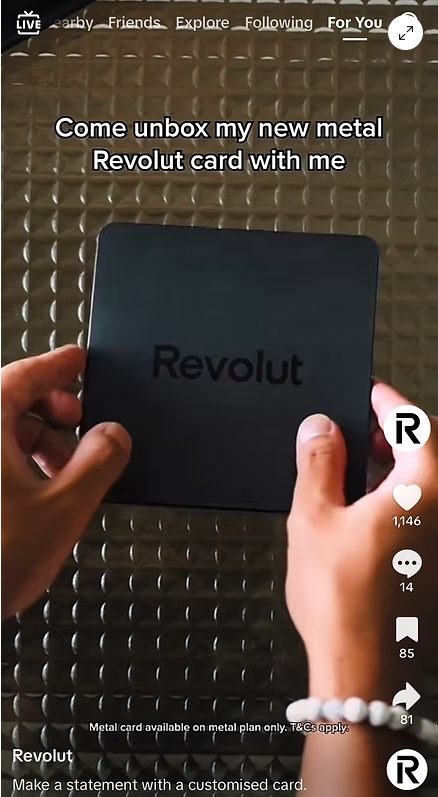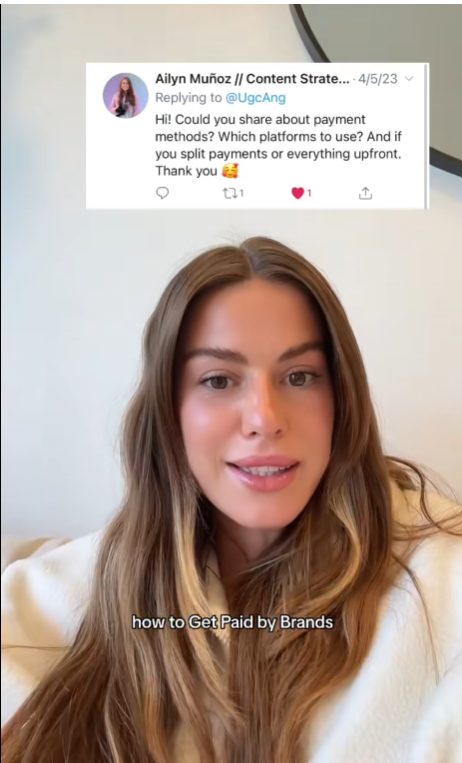Few strategies deliver as much bang for their buck as authentic user generated content (UGC). For financial services firms, forex brokers, fintechs, and neobanks, UGC offers more than just content: it brings trust, community, and measurable results. Financial services companies are increasingly integrating UGC into their marketing, onboarding, and customer retention efforts. Let’s take a look at how they’re doing it, what’s working, and how user generated content for finance can produce ROI.
Why User Generated Content Works
Consumers have evolved. They no longer take a brand’s word at face value and this is especially true when it comes to financial products or services. In fact, a landmark Nielsen study found that 92% of consumers trust peer recommendations more than traditional advertising. That trust translates into action: according to Stackla’s global consumer survey, 79% of people say UGC highly influences their purchasing decisions, far surpassing the impact of brand-created content or paid influencers.
User Generated Content For Finance: What It Looks Like
User-generated content for finance can take many forms. It could be a forex trader sharing a screen recording of their best performance or a client vlogging how a neobank helped them manage their small business finances. It can also appear in more structured community discussions, product reviews on third-party platforms, or detailed tutorials created by power users.
This kind of content is particularly powerful in a sector where credibility is crucial. When a peer explains how your platform made currency transfers easier or improved their investing or trading confidence, it’s far more persuasive than anything your marketing team could create.
What is UGC in the Context of Financial Brands?
UGC refers to any content—text, images, videos, testimonials, reviews, or social media posts, created by customers, partners, or users rather than the brand itself. In the financial sector, this includes:
- Video testimonials from real clients
- Trader performance recaps on social media
- Client tweets praising a platform’s UX
- Community forum insights
- Ambassador-led tutorial content
- Genuine user reviews on Trustpilot or Google
How Financial Brands Are Already Using UGC
Digital bank Revolut actively encourages users to share key moments like reaching savings goals or transferring money internationally. They enable this by offering pre-designed graphics and branded social media templates. They also invite community members to provide feedback through forums and surveys, which are then repurposed into blog content and feature updates. This two-way engagement strategy has paid off: according to Socialinsider, Revolut’s posts featuring real users have 30% higher engagement than content using only branded visuals.

Another standout is eToro, whose entire model is built around social trading. Its “Popular Investor” programme turns high-performing traders into public figures within the platform, encouraging them to share their trades, commentary, and strategies with followers. These trader-generated posts aren’t just informative, they’re performance drivers. A study published on Finance Magnates noted that eToro users who follow and engage with UGC-driven trader profiles show 47% higher trading activity than those who don’t.

Then there’s Wise (formerly TransferWise), which has consistently put real customer stories at the centre of its marketing. From blog interviews to the “People on the Move” YouTube series, Wise gives users a platform to talk about their cross-border financial journeys. These authentic stories not only humanise the brand, but also generate measurable results: Google reported that one of Wise’s video-led campaigns achieved a 12% increase in conversions from referral traffic.

These aren’t isolated experiments. They’re examples of how UGC, when thoughtfully managed, becomes a scalable, high-performing asset for financial firms.
Why UGC Delivers Results in Finance
One of the primary reasons UGC is so impactful in this sector is that it builds trust, something marketing departments in finance continually strive to achieve. When clients speak candidly about their experiences, potential customers perceive it as more honest and credible than slick corporate messaging.
UGC can also be cost-effective. Every video, post, or testimonial shared by a user is content your team didn’t have to create from scratch. And its performance metrics back this up. A 2024 report by Nosto found that ads featuring UGC outperform brand-created ads by up to 28%. Combine that with organic SEO benefits from community-driven forums or review platforms, and the value becomes undeniable.
Paid vs. Organic UGC: What’s the Difference?
There are two main paths for incorporating user-generated content into your marketing mix: paid ambassador programmes and organic community engagement. While they may appear similar, they function differently and serve unique purposes.
Paid UGC typically involves contracts or agreements with influencers or brand ambassadors. These individuals are compensated to produce content that aligns with brand messaging. In finance, this might look like a known trading educator walking through a platform’s features, or a crypto investor highlighting their portfolio performance via your app. Paid UGC offers a higher degree of control and can be aligned with product launches or specific campaigns. However, it’s often viewed with some scepticism, and regulators require disclosure. So too do your social media ads and posts which should be marked as a paid promotion.
Organic UGC emerges naturally when customers love your service and want to share their experiences. This could be as simple as someone tweeting about how quickly they opened an account with your neobank, or a Trustpilot review detailing a positive experience with your support team. While this type of content may be harder to control, it’s usually more authentic and often more persuasive. More on how to encourage this later.
Both types have a place in your strategy. Paid UGC is useful for scaling reach quickly or entering new markets, while organic UGC excels at building long-term credibility and community loyalty.
Encouraging UGC Without Paying for It
In the heavily regulated world of finance, handing out money in exchange for content can sometimes raise red flags. Fortunately, you can encourage organic user content in many meaningful ways that don’t involve direct payment.
Brands are finding success by spotlighting top user posts on their social channels or newsletters, giving early feature access to active community members, or awarding vouchers for lifestyle purchases within their platforms. Others run content challenges or community events, offering soft rewards like branded merch or VIP access to beta tools. The key is to provide value. This can be with recognition, exclusivity, and engagement, rather than monetary incentive.
A great example of this is the Coinbase “Onchain Summer” campaign, which invited users to create UGC using its Layer 2 network, Base. Participants weren’t paid but received exposure and limited-edition digital collectibles, reinforcing brand loyalty in a novel way.
Quick Tip: Encourage organic UGC by fostering a community, using branded hashtags, asking for reviews, and being active in social listening.
How Can You Reward Organic UGC Without Paying?
You don’t always need to spend money to incentivise quality content. Financial brands can encourage UGC organically by:
- Featuring top content in email campaigns or social feeds
- Running contests with exclusive access instead of cash
- Offering early feature access for community contributors
- Recognising top users with shoutouts, badges or rank tiers
Tip: Always get consent before you use UGC in your marketing materials.
A Checklist for Managing UGC in Financial Brands
Because financial services are subject to strict oversight, managing UGC requires careful planning and the right tools. Here’s a practical checklist to help you implement UGC safely and effectively:
- Define Your Goals: Start by identifying what you want your UGC to achieve. Are you looking to build trust, improve engagement, or capture user feedback?
- Set Clear Guidelines: Create documentation outlining what kinds of content are acceptable, how users should disclose relationships, and which legal disclaimers are needed. This is crucial for FCA, CySEC, or ASIC compliance.
- Use a UGC Platform: Adopt tools like Agorapulse, which can help you identify brand advocates, track UGC, and manage interactions across multiple platforms. Agorapulse also allows you to moderate content, assign approvals, and maintain a full audit trail.
- Launch a Branded Hashtag: Create a unique hashtag for your campaign that’s easy to remember and monitor. This allows you to track submissions and gather analytics efficiently.
- Build an Ambassador Programme: Invite advocates to take a more formal role in your community. Offer them exclusive insights, early product access, or public recognition.
- Review for Compliance: Ensure all UGC that you plan to reuse, especially in paid or promoted formats, meets compliance standards. This includes including appropriate disclaimers, disclosures and risk warnings where applicable.
- Request Permission: Always get written permission before republishing user content, even if it was posted publicly.
- Measure Impact: Use UTM links, platform analytics, and campaign dashboards to measure UGC performance across engagement, traffic, and conversions.
- Repurpose Smartly: Once approved, reuse top-performing UGC across email campaigns, onboarding flows, paid ads, app store screenshots, and website testimonials.
Discover the top influencers to follow on Linkedin for 2025.
Compliance & Risk Considerations
On the back of The European Securities and Markets Authority (ESMA), key regulator, CySEC, laid out the accepted ways to work with influencers / finfluencers on social media. Key points to stay compliant:
- Don’t share content implying guaranteed financial returns
- Always include risk disclaimers
- Use automated moderation filters (many UGC tools offer this)
- Keep UGC separate from official investment advice
- Provide training to both marketing and compliance teams
CySEC is not the only regulator alert to how influencers are using their platforms to defraud investors. The UK’s Financial Conduct Authority (FCA) has taken down hundreds of social media posts and websites operated by financial influencers as part of an international operation. Three arrest of so-called finfluencers were made due to lack of authorisation, failure to explain risks, and promises of a lavish lifestyle. Regulators from Australia, Canada, Hong Kong, Italy and the United Arab Emirates joined the FCE on the crackdown.
The Future of UGC in Financial Marketing
With the rise of AI and decentralised finance, new formats and distribution channels are emerging. AI tools are helping brands pre-screen UGC for compliance risks, flagging potential issues before they go live. Meanwhile, tokenised rewards systems like NFTs and blockchain-based points are beginning to replace traditional incentive models.
We’re also seeing a surge in community-led video content, as short-form platforms like TikTok, Instagram Reels, and YouTube Shorts become more popular with younger, mobile-first financial users. In this new era, private forums and closed messaging groups like Telegram, WhatsApp or Discord are turning into hotbeds for trusted peer-to-peer content and insights.
Whether through ambassador-led campaigns or community-driven discussions, UGC has become an essential part of the financial marketing playbook. But with great potential comes great responsibility. To benefit, financial brands must approach UGC with intention, balancing creativity and compliance, and using social-listening platforms to manage it efficiently.
If you’re ready to explore how UGC could fit into your brand’s growth strategy, let’s talk. Our team at Contentworks can help you plan, implement, and manage a UGC strategy that’s compliant and engaging. Contact us to get started.
